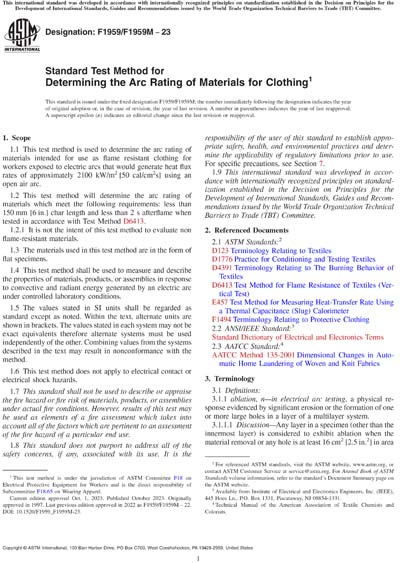Historical
ASTM F1959/F1959M-23
Standard Test Method for Determining the Arc Rating of Materials for Clothing
1.1 This test method is used to determine the arc rating of materials intended for use as flame resistant clothing for workers exposed to electric arcs that would generate heat flux rates of approximately 2100 kW/m2 [50 cal/cm2s] using an open air arc.
1.2 This test method will determine the arc rating of materials which meet the following requirements: less than 150 mm [6 in.] char length and less than 2 s afterflame when tested in accordance with Test Method D6413.
1.2.1 It is not the intent of this test method to evaluate non flame-resistant materials.
1.3 The materials used in this test method are in the form of flat specimens.
1.4 This test method shall be used to measure and describe the properties of materials, products, or assemblies in response to convective and radiant energy generated by an electric arc under controlled laboratory conditions.
1.5 The values stated in SI units shall be regarded as standard except as noted. Within the text, alternate units are shown in brackets. The values stated in each system may not be exact equivalents therefore alternate systems must be used independently of the other. Combining values from the systems described in the text may result in nonconformance with the method.
1.6 This test method does not apply to electrical contact or electrical shock hazards.
1.7 This standard shall not be used to describe or appraise the fire hazard or fire risk of materials, products, or assemblies under actual fire conditions. However, results of this test may be used as elements of a fire assessment which takes into account all of the factors which are pertinent to an assessment of the fire hazard of a particular end use.
1.8 This standard does not purport to address all of the safety concerns, if any, associated with its use. It is the responsibility of the user of this standard to establish appropriate safety, health, and environmental practices and determine the applicability of regulatory limitations prior to use. For specific precautions, see Section 7.
1.9 This international standard was developed in accordance with internationally recognized principles on standardization established in the Decision on Principles for the Development of International Standards, Guides and Recommendations issued by the World Trade Organization Technical Barriers to Trade (TBT) Committee.
ASTM International [astm]

